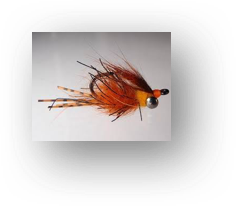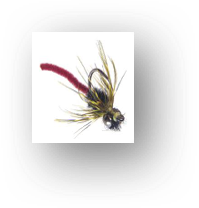Webmaster's Note: The following is a guest post from Rich Stuber, the founder of Big Sky Inflatables, home of Water Master Rafts. Water Master has been used by anglers and hunters all over the world for over fifteen years, including Dave Whitlock, one of fly fishing’s greatest innovators.
It was a warm, really pleasant day on the Dream Stream (the South Platte River) near Lake George, Colorado. Trout were hitting well on San Juan worms and nymphs, and even though the water was a bit murky, we had been catching some nice browns and rainbows. A single prince nymph under an indicator had been working well, and as the setup rounded a bend into dead water, the indicator took a dive. Raising the rod to set the hook met solid resistance so much so that it seemed as if it was hung on submerged structure. Just as quickly, the line started screaming off my reel, downstream, and the fight was on. A chase along the river bank ensued, as the 6X tippet on my line wouldn’t hold for long. After a strong fight, the fish rolled the surface and revealed the bright gold scales of a five pound common carp. This was no disappointment, as any fiver on a fly rod is a treat. The "freshwater redfish" as many call carp, is the newest and maybe the most challenging target for many anglers today.

There are five species of carp that we see in the U.S.
- Grass Carp, up to 60” long, 99lbs., feed on aquatic plants
- Big Head Carp, up to 60” long, up to 110lbs., feed on zooplankton
- Black Carp, up to 48” long, up to 78lbs., feed on snails, mussels, invertebrates
- Silver Carp, up to 40” long, up to 110lbs., feed on photo plankton
- Common Carp, up to 40” long, up to 100lbs., feed on water plants, crustaceans, crawfish, benthic worms, scuds, san juans, snails, clams
There are some variants such as the Mirror Carp, with larger scales, varied colors and placement; and the Leather Carp, with no scales, except some near the dorsal fin.
 Typical targets in fly fishing are common carp and grass carp. The habitat of carp is varied and they are found in a wide variety of waters all across the United States. Most typically, they’ll be found on flat areas, such as in Lake Michigan, in slow and slack water in creeks, streams and rivers, and in just about any lake you come across.
Typical targets in fly fishing are common carp and grass carp. The habitat of carp is varied and they are found in a wide variety of waters all across the United States. Most typically, they’ll be found on flat areas, such as in Lake Michigan, in slow and slack water in creeks, streams and rivers, and in just about any lake you come across.
Fly anglers typically look for carp along the edges in shallow water, because fishing for carp is mostly a sight-fishing event. It can be very difficult to place a fly in the right place to be taken if you cannot see the fish, and the take itself is hard to detect without seeing it happen. That doesn’t mean that a carp won’t slam a fly, because sometimes they will.
Depending on the food source they have, their eating habits will differ-sucking in clams on the bottom, eating nymphs in the water column as they swim along, chasing bait fish in the shallows, or rising to slurp in a floating mulberry or dead insect on the surface. When feeding, they’ll swim along, looking side-to-side, searching or be head-down, tail up, eating from the bottom (tailing).
Gear for Carpin’
- Carp are strong and large, usually weighing five pounds or more, so a strong rod is necessary. A 6-8 weight rod is recommended, and 9’ works well. Beside the strength of the fish, one needs the ability to fling weighted flies into the wind on occasion.
- Nothing fancy on fly line, just match the line to the rod.
- A good reel, with capacity for backing is important, because even a ten pound carp can take you well into your backing, and make several runs. They habitually bolt when you try to get them to the net, often for a fresh strong run.
- You’ll want strong leader, ten-pound test or better, and in most cases, monofilament is fine. You can use a redfish or bass tapered leader, 3X or stronger, for better turnover, but in most cases the mono is adequate. Whether to use nylon or fluorocarbon is your choice, the carp masters differ in their opinion of which is best.
 Flies
Flies
Many carp anglers tie specialty flies for catching carp, imitating the food sources, such as the Hybrid Carp Fly or the Backstabber, popular mainstream carp flies. The reality is that much of the time you’ll catch carp doing the same thing you do with trout - match the hatch.
- Aquatic creatures-carp eat nymphs and pupa of mayflies, dragonflies, damsel flies and stoneflies, so flies you use to imitate those work
 Plant material-they like fluffy cottonseeds and love mulberries, so flies that look like those two foods work
Plant material-they like fluffy cottonseeds and love mulberries, so flies that look like those two foods work- Introduced foods - if you fish an environment with human presence, carp will be eating things thrown into the water, and there are flies to imitate foods like bread, dog food, corn, etc.
- Try these: GR Hare’s Ears, dragonfly nymphs, scuds, leeches, san juan worms, crawfish, woolly buggers, Carp Boobies, Bristle Leeches
 Some popular concepts: weighted flies that sink, hook point up, flies with legs that stir up mud or silt
Some popular concepts: weighted flies that sink, hook point up, flies with legs that stir up mud or silt- Tips: clear water - smaller flies; murky water- larger, darker flies
Methods
- GOOD - indicator rig dead drifting the fly just above the bottom, slowly stripped (no wake on the indicator). This method good for murky water where sight fishing is difficult.
- BETTER - drag and drop, casting a two-fly rig beyond the fish, dragging the setup across the surface until the flies are on either side of the carp’s head, then allowing the flies to drop to the bottom.
- BEST - drop the fly one to two feet directly in front of the feeding carp, and watch for the take, when the carp sucks in the fly.
- Strip set is always best, as it is easy to pull the fly out of the carp’s mouth if you trout set by lifting the rod tip.
Tips
- Rub your fly with mud, they have a keen sense of smell.
- Study the water, don’t just start throwing flies - sight fishing to specific carp is most productive.
- Carp like stable weather patterns.
- Watch for tailing, or puffs of mud.
- If you miss a take, let the fly drop, don’t give up.
- Look for tilted fish. When they are cruising level, they’re not eating.
- Try bright flies, carp are curious and will pick up bright objects.
- It’s ok to let your fly ‘sploosh’ on the water, it gets their attention.
- Be stealthy, carp are nervous fish, easy to spook.
- Cast in front of fish, not over them, they ‘line’ easily.
- If you find carp, but they’re not feeding, look for some that are.
The next time you want some excitement, and want to catch a big fish on a fly rod, consider looking for carp. You will be surprised how many bodies of water they inhabit in your area. You may have to do some searching to find them, but the reward of a 7-10 pound hard-fighting fish on the fly rod is worth every step you take. Go carpin’!
If you would like to learn more about fly fishing for carp be sure to check out these podcasts Cruising for Carp and Tactics for Monster Carp.


